Tag: Chris Hill
The Big Chill — We Felt it through the Grapevine
It takes years of hard work to establish a vineyard, but only one bad night to lose it.
A week ago Wednesday, I thought that night was upon us. With subzero temperatures in the forecast, it seemed as though we might have been on the verge of losing our little hobby vineyard, which has been the focus of so much of our time and energy for the past four years.
To jump to the end of the story for just a moment, we spent a long day working in the vineyard on Thursday and a long night of checking the temperature on an hourly basis and begging the climate gods to show some mercy. And when I climbed out of bed Friday morning, I was feeling much more optimistic. We won’t know for sure until later in the year, but I believe that our vineyard survived, though not without some degree of injury to the vines.
We had known for several days that severely cold weather was on the way, but it had seemed as though it would be manageable. We monitor a number of weather services – WxRisk, Weather Underground, and the Weather Channel among them – and the latter two provided forecasts that varied daily. (They also vary between each other. Sometimes I pick the one I like best and lull myself into a false sense of security.)
So, the outlook for early Friday morning looked very different on Wednesday than it had only a few days earlier. Negative five degrees had been scary enough. But I was really surprised to see forecasts that warned of temperatures as low as minus 13 degrees Fahrenheit.
Now, our vines can do just fine in freezing weather, and they’ll even manage through sub-zero temperatures. At some point, though, you can expect injury. Everything I’ve read – I’ve never experienced it, but I’ve done a fair amount of reading – suggests that at negative five degrees we should expect to lose at least some of the buds that would produce shoots and grapes in the coming growing season.
And at negative 13?
Well, the damage could be catastrophic. Buds are more sensitive to the cold than trunks and canes, but only by a few degrees, according to Virginia Tech’s Tony Wolf, who was good enough to put out an alert Wednesday with lots of information about the effect of freezing weather on vines.
Losing a significant number of buds and part of next year’s harvest would be bad news. But it’s one thing to lose part of the crop and quite another to lose the entire vine. At some temperature, the scion – the actual vine, which is grafted onto rootstock – could be killed. If that happens, there’s little alternative but to replace the vine.
That would be disastrous for anyone, and my heart goes out to commercial vineyards that might have lost either a substantial portion of the 2015 crop or some part of their vineyard. For them, it’s everything. For us, it’s a hobby, not our livelihood, so it would be incredibly self-centered for me to complain too much about our potential loss.
Having said that, though, the prospect of losing vines hit me on a very personal level. We’ve spent more than four years getting to this point, and I feel like I remember almost every minute of the hard work and sacrifice.
But forget, for a moment, about the time we spent taking classes, reading and talking to vineyard managers to learn everything we could about viticulture. And forget about the cash outlays. Let’s also put aside the hours of physical labor that went into establishing the vineyard. (Well, not too far aside – I can still remember a day last summer, working five hours with a backpack sprayer and thinking I was just about ready to die by the time I finished.)
As important as all those things are, what matters most to me is the time – the number of years it takes to order vines, plant them, and nurse them through to their first harvest. We all have only so much time in this life. And that means we get only so many chances to get it right.
So yes, we could start over again. We could order vines, but we wouldn’t be able to get the vines we want this year, so we wouldn’t be able to plant until the spring of 2016. And it would be another three growing seasons before we harvest again. That would bring us to the fall of 2018, which seems like forever.
We did have a couple of things going for us. First, we had a couple of weeks of freezing weather leading up to the big chill, which helped harden off the vines. That meant they should have been able to withstand lower temperatures than would have been the case if the deep freeze had hit all at once.
Second, we had a blanket of snow on the ground. Snow has an insulating effect, and if it’s deep enough, it can protect the graft union, where the scion is joined to the root stock. In our first two years, we had hilled up around the vines, creating a mound of dirt a couple of inches above the graft union to provide the same kind of insulating effect. This year, with the harvest and all of the time and labor that goes into fermenting five different varieties of wine, we just didn’t get to it. Lesson learned.
Third, we’ve planted varieties that are reasonably cold-hardy, including Cab Franc, Petit Verdot, Petit Manseng, and Viognier. The exception is Merlot, which is much more sensitive to cold injury. The Merlot is also the youngest of the varieties we planted and therefore the least able to take winter’s punch.
For all that, though, we were pretty worried. By the end of the day Wednesday, the Vineyard Goddess and I had decided to spend Thursday doing everything we could to protect the vines. Our plan was to use mulched and partially composted leaves and grass to hill up around each vine, in the hope that we could insulate the graft union to the point that we could save the vine, if not this year’s harvest.
We traveled to Afton Wednesday night so that we could get an early start the next morning. Sometime around 8 a.m. Thursday we made our first foray into the vineyard. It was about 3 degrees above zero and the wind was blowing. I was colder than I think I’ve ever been in my entire life, and we went back inside to add a couple of layers of clothing, have a cup of coffee, and wait for the temperature to reach a more civilized 6 degrees or so.
By 9 a.m., we were working in earnest. Over the years, I had dumped a large volume of leaves and grass clippings into a heap on the other side of our property, and we had a very large pile by this point that was just waiting to be repurposed. I used the front-end loader on my tractor to haul them into the vineyard where the VG mounded them around each vine. Here and there we added some snow to pack the mulch down, but mostly, we relied upon the organic matter to insulate the vine.
The overnight temperature readings were somewhat milder than the forecast, but they were still pretty severe. At 7 a.m., the temperature hit minus 6.1 degrees, according to the Weather Underground station closest to us. I would have preferred to have our own weather equipment in the vineyard, but this station is not only close, it’s also at the same elevation as our vineyard, so I expected that the readings would be very close to what we would have gotten if we had a thermometer on our own property.
In the next week or so, we’ll be sampling buds and canes to see how well we survived the big chill. This is a first for us, and I have no idea how we did. But I can say this: I feel a whole lot better because of the work we did. Even if we lose the vineyard – which I think is a low probability outcome – I’ll feel better knowing that we did everything we could. If we had done nothing at all and lost only half the vineyard, I would feel much worse.
Wine grape growing is agriculture and like farmers everywhere, we live at the mercy of whatever Mother Nature throws at us. As Chris Hill, one of Virginia’s vineyard pioneers, told me during one of our classes – and this is a major paraphrase – the averages (temperature, etc.) are important, but it’s the records that kill you. And this year was one for the books.
A Tough Year for a Weekend Vintner
It was a tough year to be a weekend vintner.
When you’re separated from your vineyard by a two-hour drive, you have to make the most of your time. And we try. But the weekends are short, and there’s so much to do. And every curve that Mother Nature throws your way puts you just a little bit further behind. This year, Mother Nature was throwing curves, sliders, and the occasional spitball.
This year began with a late spring frost, followed by rain. Not just a little rain, but lots of rain, which gave rise to all kinds of fungal disease potential. Powdery Mildew, Downey Mildew, Botrytis, you name it.
And then came the pests: Japanese beetles, birds, raccoons, squirrels, deer, and even bears. Yes, indeed, bears. No lions or tigers,though. Just birds, deer and bears. And yeah, racooons and beetles and the rest of the pests.
That’s one of the reasons I’ve not been able to pay much attention to this blog. Another was that Chris and I took on responsibilities for editing Grape Press, the quarterly publication of the Virginia Vineyards Association. But mainly it was the challenges of the growing season. It seems like we spent all of our spare time each weekend keeping up with the vineyard. Spraying, cultivating, pruning, and spraying. Yeah, lots of spraying. It wasn’t easy.
Let’s start with the late frost. I remember arriving at the vineyard early one Saturday morning to find our whites all but devastated. Honestly, it looked as though someone had sprayed Round-Up and left them to die. For a while, I actually wondered if they had been the victims of spray drift from the herbicide we had used to clear a row for new the new vines we had planted this year.
Fortunately, that was not the case.
After checking the temperatures recorded nearby, I realized that we had probably experienced at least one and possibly two frost events in which temperatures had dropped just below freezing for a few hours in the early morning. My reds were fine, but they are planted higher on the slope and there’s a good possibility that temperatures stayed a degree or two higher in their part of the vineyard. Alternatively, bud break came earlier for the whites and they may have just been victims of bad timing. I’ll never know.
It turned out okay, though. Both the Petit Manseng and the Viognier had enough secondary buds left to generate growth for this year. Within a few weeks, we were seeing buds break and shoots begin to develop. And by the middle of the summer, they were looking like grape vines again. So, all was well.
But then it started to rain. Continue Reading–>
Finding the Perfect Spot to Plant Vines
It’s hard to imagine anything more important to the establishment of a great vineyard than the selection of the right piece of land, yet hardly any step gets less attention from home vintners. That’s because most of us use the land we already have. And even those of us who search for a property with a vineyard in mind sometimes give less than full attention to the site’s suitability for growing wine grapes.
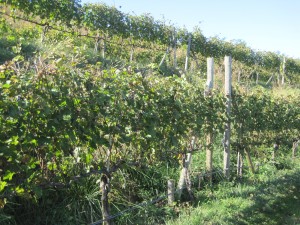
- Slopes are good for vineyards, but this is almost too much. Try getting your tractor across it without tipping.
I can attest to that. Before buying our Nelson County home, we looked at something on the order of 45 properties. Initially we set our parameters at five acres or more, preferably 10. We excluded properties that were wooded (“private” in real-estate speak), and those that were at too low an elevation to provide safety from winter freezes. We wanted slope, we wanted an eastern aspect, we wanted land that was so infertile that a farmer would turn his nose up at it. (Bad soil is ideal for wine grape production, but that’s a story for another post.)
And in the end, we bought a property that was only three acres, with a western aspect and tall trees on the eastern border that would limit sunlight in the morning. So what in the name of all that’s holy were we thinking?
Well, this is the home we plan to retire to in a few years, and we pretty much just fell in love with it. It’s a great house with beautiful mountain views. And it does have a few things going for it as a vineyard property: slope (almost too much slope), really crappy soil, good drainage, and a small section at the western end that we believe will get sufficient sunlight for grape production. Continue Reading–>

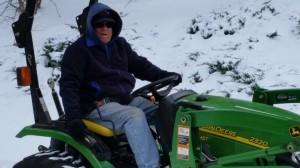
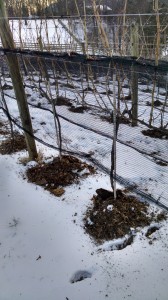
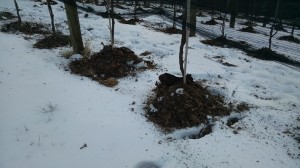
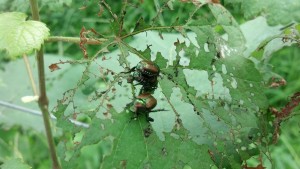


Recent Comments